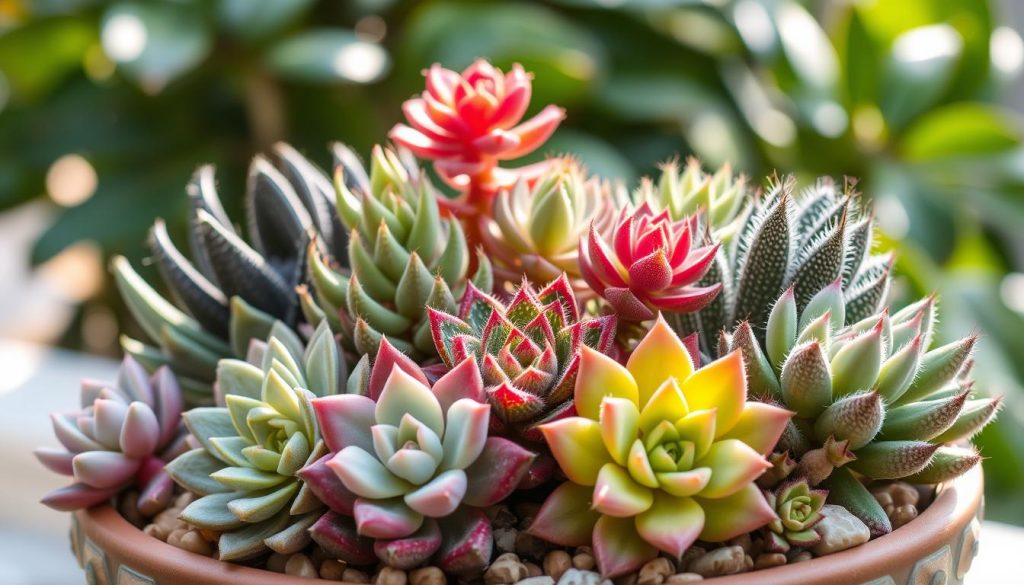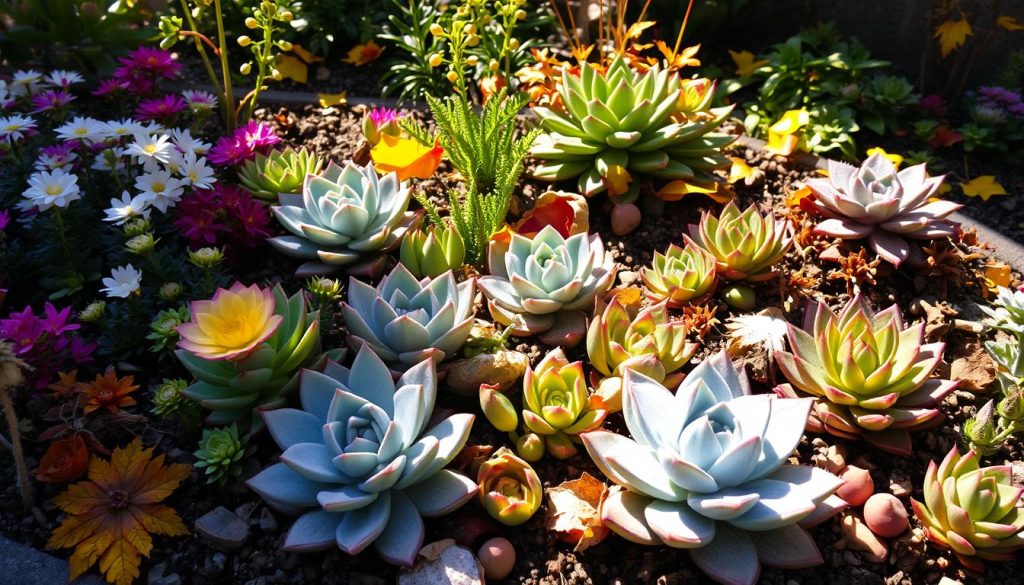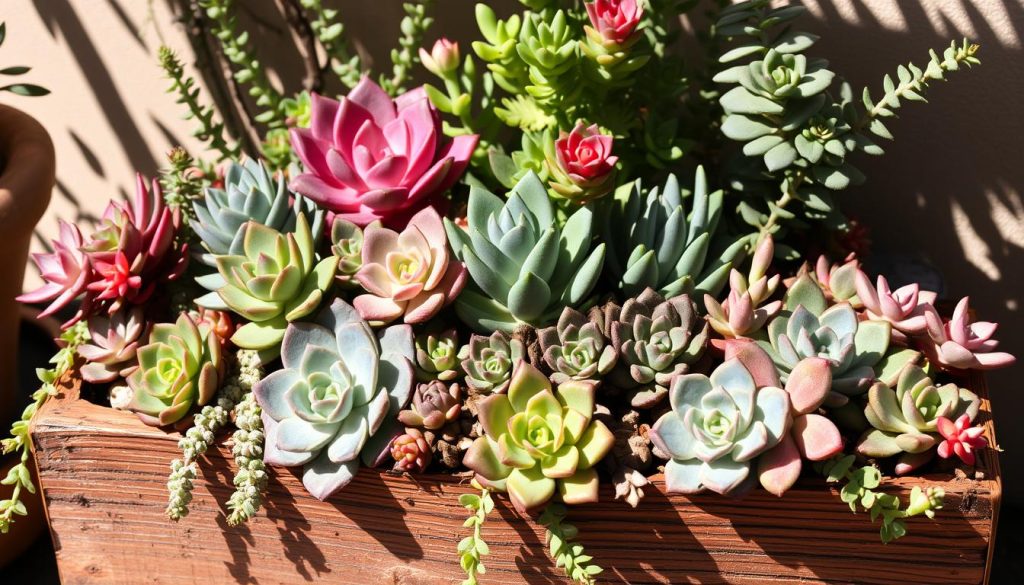Succulents are easy to care for and can grow well indoors and outdoors. They store water in their leaves, stems, or roots. This makes them perfect for both new gardeners and seasoned experts. This guide will help you learn how to care for succulents, from choosing the right ones to keeping them healthy all year.

Key Takeaways
- Succulents are low-maintenance, versatile plants that can thrive indoors and outdoors.
- Beginners should start with easy-to-care-for varieties like Haworthia, Jades, Gasterias, and Vicks plant.
- Proper soil, container, and watering techniques are crucial for healthy succulent growth.
- Succulents require ample sunlight, either from natural or artificial sources.
- Outdoor succulent gardening offers additional benefits, but plants may need protection in extreme weather.
Understanding Succulents: What Makes Them Unique
Succulents are amazing plants that live well in dry places. They store water in their thick leaves and stems. This lets them survive in very dry conditions. You’ll find many types, like Echeveria, Sedum, and Haworthia.
Types of Succulent Plants
Succulents vary a lot in size, shape, and color. Some grow small and round, while others spread out. They are beautiful and loved by many.
Natural Habitats and Adaptations
Succulents have special ways to live in dry places. They keep water in their leaves and stems. They also have special roots and leaves that help them save water.
Key Characteristics of Succulents
- Fleshy, water-storing leaves and stems
- Compact, often rosette-like growth habits
- Specialized adaptations for water conservation
- Ability to thrive in arid, harsh environments
- Diverse range of shapes, sizes, and colors
Succulents are truly special plants. They have unique features and come in many shapes. They are great for indoor and outdoor gardens, adding beauty and toughness.
Best Succulent Varieties for Beginners
Succulents are loved by many gardeners for their easy care and beauty. For new gardeners, some succulents are especially easy to grow. These easy-care succulents and beginner-friendly plants can handle mistakes and don’t need much water.
The Haworthia, or Zebra plant, is a great choice for beginners. It’s safe for pets and grows well in zones 9a to 11b. Jade plants are also good, with their unique leaves and ability to thrive indoors or outdoors.
Gasterias and Elephant Bush are also great for beginners. They have thick leaves and are easy to care for. These plants are tough, don’t get many pests, and are easy to grow.
When picking easy-care succulents, think about what they like, their hardiness zones, and how to care for them. Choosing the right ones can make gardening fun and easy, even if you’re new to it.
Essential Growing Conditions for Indoor Succulents
Bringing succulents into your home is a joy. But, to keep them thriving, you need to know their growing needs. This includes temperature, humidity, and air circulation. Let’s dive into these key factors for healthy, vibrant houseplants.
Temperature Requirements
Indoor succulents love temperatures between 60-80°F (15-27°C). They can handle small changes but prefer a steady climate. Keep them away from vents, electronics, and dark spots to avoid stress.
Humidity Levels
Succulents don’t need much humidity. They actually do better in dry air. Low humidity prevents moisture buildup, which can harm your plants.
Air Circulation Needs
Good air movement is vital for your succulents. It keeps them safe from fungi and pests. Place them where air flows well, like near windows or with a fan.
With the right temperature, humidity, and air, your succulents will flourish. They’ll become beautiful, easy-to-care-for houseplants.
Selecting the Perfect Container for Your Plants
Choosing the right container is key for growing potted plants, especially succulents. They do well in pots that let water drain and breathe. Terra cotta pots are great because they soak up water and prevent root rot.
The size of the pot matters too. Small pots keep succulents from growing too big. But, big pots can hold too much water. It’s best to leave a little space between the plant and the pot’s edge. This lets your succulents grow without drowning.
- Terra cotta pots are ideal for succulents due to their breathable, porous nature.
- Ceramic pots offer a wider range of design options and are often used for succulent displays.
- Plastic pots are inexpensive and versatile but require close attention to drainage.
- Concrete pots are durable and drainage-friendly, but can be heavy and more expensive.
- Wooden containers like driftwood add unique visual appeal but may not have the longevity of other options.
- Glass containers, while visually appealing, lack the necessary drainage holes for healthy succulents.
When picking pots, make sure they have holes for water to drain. This stops water from building up and causing root rot. Moving your succulents to a new pot within 24 hours can also help them thrive. The right container is essential for your plants’ success.
Soil Requirements and Potting Mix Guide
Succulents need well-draining soil to avoid root rot. The best mix combines organic and mineral parts for good drainage and air. You can make your own mix or buy a cactus mix to meet their needs.
DIY Succulent Soil Recipes
Start with two parts sand, two parts potting mix, and one part perlite or pumice. This mix holds moisture but drains excess water well. Use all-purpose sand, not play sand, to prevent soil compaction.
- 2 parts sand
- 2 parts potting mix
- 1 part perlite or pumice
Commercial Soil Options
Many commercial mixes are made for succulents and cacti. These mixes have ingredients like cactus mix, perlite, and pumice. Brands like Miracle-Gro and Bonsai Jack offer good well-draining soil options.
Choose a commercial soil with a pH between 6.0 and 7.0. This range is best for most succulents. Stay away from heavy, clay soils that hold too much water and cause root rot.
Proper Watering Techniques and Schedule
Watering your drought-tolerant plants, like succulents, right is key to their health. Succulents do best when the soil is completely dry before watering again. Too much water can cause root rot and harm these plants.
The watering schedule for succulents depends on several factors. These include the climate, pot size, and type of succulent. Generally, indoor succulent owners water every 14-21 days. But remember, every succulent is different, so their watering needs can vary.
- Water succulents only when the soil is completely dry. This usually takes 2-3 days, depending on the soil and pot.
- When you do water, make sure the soil is soaked well. Let any extra water drain from the pot.
- Outdoor succulents might need more water because of more sun and other environmental factors.
- In the winter, when succulents are dormant, water them less. They need less moisture then.
- Watch for signs of under-watering, like wilted or shriveled leaves. Adjust your watering schedule if needed.
Getting the watering right is crucial for your drought-tolerant plants’ health. By following these tips and watching your succulents, you can help them flourish. They will add beauty to your indoor or outdoor spaces.
Light Requirements for Healthy Growth
Succulents can grow well in many lighting conditions. But, they need the right amount of light to stay healthy. Most succulents need bright, indirect light for at least 6 hours a day. South-facing windows are great for indoor succulents.
When you bring new plants home, start them off slow. This helps them get used to the light without getting stressed or sunburned.
Natural Light Sources
Outdoor succulents need different amounts of sunlight. Full sun plants like Agave and Prickly Pear Cactus need up to 8 hours of direct sunlight. Plants that like partial sun, like Copper Pinwheel and Echeveria, do well with 4 hours of sunlight.
Shade-loving succulents, like Rhipsalis and Sansevieria, only need 2 hours of sunlight a day.
Artificial Lighting Solutions
In places with little light or during winter, grow lights can help. These lights give the right intensity and spectrum for growth. Make sure to place plants close to the light and rotate them for even light.
Watch how your succulents react to light and adjust as needed. The right light, whether from the sun or artificial sources, helps them stay healthy and look great.
Outdoor Succulent Gardening Tips
For those looking to add succulents to their outdoor spaces, there are important things to remember. When picking succulents, choose ones that fit your local climate. Succulents do best in soil that drains well or in raised beds to avoid water problems.
Rock gardens and ground cover are great for showing off succulents’ unique looks. Grouping succulents by their water and light needs makes caring for them easier. Also, protect them from harsh weather like frost or too much heat by providing shelter or moving them.
- Choose succulents suited to your climate zone for optimal growth
- Plant in well-draining soil or raised beds to prevent water accumulation
- Consider using succulents in rock gardens or as ground cover
- Protect plants from extreme weather conditions like frost or intense heat
- Group plants with similar water and light needs together for easier care
By following these tips, you can create a beautiful and easy-to-care-for outdoor space. Succulents are not only beautiful but also tough and adaptable.
Seasonal Care and Maintenance
Caring for succulents means changing your routine with the seasons. In winter, protect them from frost and cold. In summer, water more and shade them to keep them healthy.
Winter Protection Methods
When it gets cold, water your succulents less to avoid root rot. If frost is a problem, cover them with a cloth or bring them inside. Some succulents may slow down or drop leaves in extreme cold. Start your usual care again when spring comes.
Summer Heat Management
- Give them plenty of shade during the hottest hours to avoid sunburn and dehydration.
- Water them more often if the soil dries out fast, making sure the roots stay moist.
- Watch for signs of dormancy, like slower growth or leaf loss, and adjust their care as needed.
By paying attention to seasonal changes and adjusting your care, your succulents will thrive all year. Remember, the right succulent care and seasonal maintenance keep your collection looking great.

Propagation Methods and Techniques
Succulent propagation is a great way to grow your plant collection or share with friends. You can use leaf cuttings, stem cuttings, or offsets. The first step is to let the cuttings dry before planting them in soil that drains well.
Leaf cuttings are a favorite for many. Just take a healthy leaf, let it dry for a few days, and then plant it in soil. Soon, a new plant will grow from the leaf. This works well for plants like Graptopetalum, Kalanchoe, and Crassula.
Stem cuttings are also effective. Pick a strong stem, cut it just below a leaf, and let it dry. Then, plant it in soil and watch for new growth. This method is good for Aeonium, Echeveria, and Cotyledon.
- Offsets, or “pups,” are baby plants that form around the base of the parent succulent. These can be gently separated and replanted to create new plants.
- Some succulent species, like Sansevieria, can even be propagated from a single leaf section.
- Proper lighting, well-draining soil, and patience are essential for the successful propagation of succulents.
Keep your environment clean and sterilized to avoid diseases. With the right techniques and care, you can grow more succulents and share them with others.
Common Pests and Disease Management
Succulents can face many pests and diseases. These can harm their health and look. It’s important to spot problems early and act fast to keep your succulents thriving.
Identifying Plant Problems
Common issues include mealybugs, aphids, and root rot. Check your plants often for signs like thin, pale, or spindly leaves. This helps catch problems before they get worse.
Natural Treatment Solutions
- Use neem oil or insecticidal soap to control pests like mealybugs and aphids.
- Stop fungal diseases like root rot by not overwatering and keeping air moving around your plants.
- Keep sick plants away from healthy ones to stop disease spread.
- Use pre-emergent herbicides or natural weed killers to keep weeds from competing with your succulents.
- Be gentle when handling leaves with farina to avoid damaging the protective coating.
By being watchful and using natural treatments, you can manage succulent pests and plant diseases. This keeps your succulent collection healthy and vibrant for a long time.
Creative Display Ideas and Arrangements
Make succulents a focal point with creative displays. These plants are perfect for adding beauty to your home or garden. You can create unique container gardens or vertical living walls.
Try mixing succulents with different colors, textures, and shapes. Use terrariums, hanging baskets, or vintage items for a unique look. Vertical arrangements or living walls can also save space.
- Experiment with a variety of container materials, such as concrete, metal, wood, glass, and even recycled items like tin cans or teacups.
- Incorporate natural elements like moss, pebbles, and driftwood to create a cohesive, earthy aesthetic.
- Mix and match succulents with cacti to add visual interest and depth to your arrangements.
Succulents are great for making stunning centerpieces or lush walls. Let your creativity shine and make displays that show off your style.

Cold-Hardy Succulent Varieties
Winter-hardy succulents and frost-tolerant plants are perfect for cold climates. They add greenery to outdoor spaces all year. These plants are great for gardeners who want to keep their gardens looking good.
Sempervivum, or Hen and Chicks, can handle temperatures as low as -4°F (-20°C). They are ideal for USDA hardiness zones 4-7. Sedum species, like ‘Golden Glow,’ can survive -22°F (-30°C) and look vibrant.
Agave plants, like Queen Victoria Agave and Variegated Butterfly Agave, can handle mild frost. They thrive in temperatures above 41°F (5°C). The Rosularia platyphylla can even handle -20.02°F (-28.9°C).
- Pachyveria pachytoides: Tolerates freezing temperatures as low as 14°F (-10°C)
- Sempervivum Arachnoideum: Withstands freezing temperatures down to 14°F (-10°C)
- Oscularia Deltoides (Pink Iceplant): Endures mild frost above 41°F (5°C)
- Aloe ‘Blue Elf’: Survives temperatures as low as 20°F (-6°C)
- Graptopetalum paraguayense: Revives after winter frost, tolerating 5°F (-15°C)
When growing these hardy succulents, make sure they have good drainage. Also, protect them from too much moisture. With the right care, they can brighten up your garden even in the cold months.
Fertilizing and Nutrition Guidelines
Succulents need little fertilizer but the right nutrients boost their growth. It’s important to find the right balance. Too much fertilizer can cause weak growth, while too little can stunt them.
When they’re growing actively, from spring to summer’s end, use a balanced fertilizer. Dilute it to half-strength and apply every 4-6 weeks or with each watering. Don’t fertilize in winter, as it can harm the roots.
- Balanced NPK ratio of 2-4-2 is recommended for synthetic fertilizers
- Organic fertilizers, such as compost or bone meal, can also be beneficial for succulents
- Cacti prefer a higher potassium ratio compared to other succulent varieties
- Ensure succulents are well-hydrated before applying fertilizer to prevent root burn
Apply fertilizer carefully, as too much can harm your succulents. It can cause leaf burn and make them less drought-tolerant. The right amount of nutrients helps them stay healthy and compact.
Conclusion
Growing succulent plants is rewarding for all levels of enthusiasts. They need the right care to thrive indoors and outdoors. Succulents prefer less water, making them perfect for busy people or those who forget to water.
These plants come in many colors, shapes, and sizes. They can make any space look better. With the right light, soil, and water, your succulents will grow well and add to your home’s beauty.
Whether you’re new to succulents or experienced, caring for them is fulfilling. They teach us about being adaptable and growing. The joy of succulent care is seeing them thrive with little effort, enhancing our surroundings.